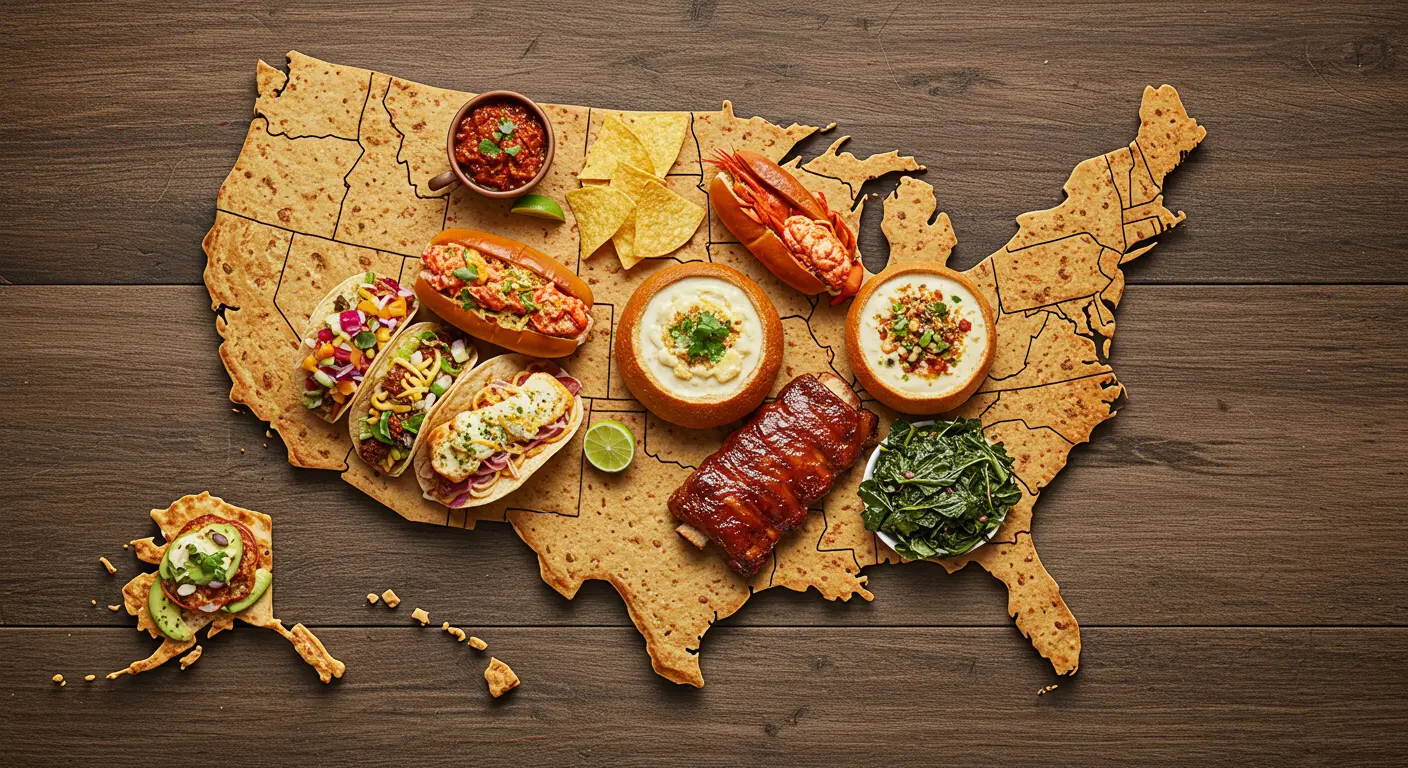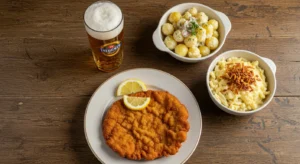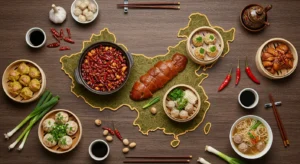Table of Contents
A Beginner’s Guide to the Deliciously Diverse World of United States Food: American Food
Let’s be honest. When you think of “United States food,” what’s the first thing that pops into your head? A giant hamburger? A box of takeout pizza? A plate of sizzling barbecue?
You’re not wrong. Those are all iconic American eats. But if that’s where the story ends, you’re missing out on one of the most exciting and diverse food cultures on the planet.
The truth is, American cuisine is a thrilling, ever-evolving story. It’s a tale of immigration, innovation, and immense geographical variety. It’s the story of Native American traditions blending with flavors from every corner of the globe, creating something uniquely… American.
Feeling a little overwhelmed? Don’t worry. This guide is your friendly roadmap. We’re going to slice through the clichés and explore the real heart of United States food. By the end, you’ll not only know what to eat but understand the “why” behind it all.
So, What Exactly is American Cuisine? The “Melting Pot” on a Plate
This is the million-dollar question. Unlike countries with centuries of uninterrupted culinary history, American food is defined by its diversity. It’s less a single, monolithic tradition and more a vibrant tapestry woven from countless others.
The famous idea of America as a “melting pot” is perfectly illustrated on its dinner plates. Waves of immigrants brought their recipes, their spices, and their cooking techniques. These traditions didn’t just stay isolated; they bumped into each other, borrowed ingredients, and adapted to what was available. Italian tomato sauce met American wheat for a new kind of pizza. German sausages found a home in a bun at baseball games. West African cooking practices fundamentally shaped the soul food of the American South.
This constant fusion and adaptation is the American culinary experience.
A Cross-Country Road Trip on a Plate: Regional Specialties
One of the best ways to understand United States food is to take a virtual road trip. The flavors change dramatically from coast to coast, each region boasting its own iconic dishes.
The American South: Where Food is Soul
Southern food is deeply rooted in history, with influences from West Africa, Europe, and Native Americans. It’s known for its bold, comforting, and often hearty flavors.
- BBQ: This isn’t just grilling burgers in the backyard. American barbecue is a serious art form, with fierce rivalries between states. North Carolina swears by its vinegar-based pulled pork. Texas is all about beef brisket with a smoky dry rub. Kansas City is famous for its sweet, tomato-based sauce slathered on ribs. It’s a delicious rabbit hole to fall into.
- Soul Food: This cuisine, born from African American culture, is the ultimate comfort food. Think crispy fried chicken, collard greens simmered with smoked turkey, creamy macaroni and cheese, and fluffy cornbread. Every bite tells a story of resilience and community.
- Cajun & Creole (Louisiana): Often used interchangeably, they’re distinct. Cajun country food is rustic and spicy, like gumbo (a rich stew) or jambalaya (a rice and sausage dish). Creole food from New Orleans is more refined and city-influenced, with famous dishes like shrimp étouffée and beignets (square doughnuts covered in powdered sugar).
The Northeast: Classics with a Coastal Twist
This region is steeped in early American history and has a strong connection to the sea.
- New England: Think chowder—specifically, clam chowder. The New England style is creamy, packed with clams, potatoes, and served in a bread bowl. Don’t forget the lobster rolls: fresh, sweet lobster meat lightly dressed in mayo and served on a buttered, grilled hot dog bun. Pure summer bliss.
- New York: The city is a food microcosm of the world. But its claims to fame are the foldable, greasy New York-style pizza slice and the giant, everything-spice bagel topped with a thick schmear of cream cheese.
The Midwest: The Heartland’s Comforting Bounty
Known as America’s “breadbasket” for its agricultural output, Midwestern food is unpretentious, hearty, and built to feed families.
- Casseroles: The infamous “hotdish” (as it’s called in Minnesota) is a staple. It’s a baked dish combining a protein, a starch like potatoes or tater tots, vegetables, and a creamy soup binder. It’s the definition of comfort.
- Chicago-Style Deep Dish Pizza: Forget everything you know about thin-crust pizza. This is a pie: a thick, buttery crust filled with cheese, toppings, and a chunky tomato sauce on top. It’s a meal unto itself.
The West & Southwest: Big Flavors and Fresh Ideas
This vast region is defined by Mexican and Asian influences, alongside a focus on fresh, local, and innovative ingredients—the birthplace of “California Cuisine.”
- Tex-Mex: A fusion of Texan and Mexican cooking, giving us beloved dishes like sizzling fajitas, cheesy enchiladas, and crispy tacos served with chips and salsa.
- California Cuisine: This movement, championed by chefs like Alice Waters of Chez Panisse, revolutionized American dining in the 1970s. It emphasizes fresh, local, seasonal, and organic produce. Think avocado toast, gourmet fish tacos with cabbage slaw, and salads topped with goat cheese and candied walnuts. It’s fresh, healthy, and flavor-forward.
- Pacific Northwest: With access to incredible seafood, you’ll find amazing salmon, Dungeness crab, and oysters everywhere. The region is also a huge hub for coffee culture (hello, Starbucks birthplace) and craft beer.
More Than Just a Meal: Understanding American Food Culture
The food itself is only half the story. How Americans interact with it is just as important.
- The Rise of “Food TV” and Celebrity Chefs: From Julia Child introducing French cuisine to America to the competitive drama of shows like Top Chef, television has shaped how Americans think about food, turning chefs into rockstars and inspiring a nation of home cooks.
- The Diner: An American Icon: The classic diner, with its chrome exterior and endless menu, is a cornerstone of American culture. It’s where you can get pancakes at midnight, a club sandwich at noon, and a slice of pie any time of day. It represents accessibility and comfort.
- The Modern Food Scene: Fusion & Food Trucks: Today’s American food scene is more dynamic than ever. Food trucks offer gourmet, innovative meals on the go, from Korean BBQ tacos to vegan ice cream. Fusion cuisine continues to evolve, with chefs freely mixing techniques and ingredients from different cultures, creating exciting new dishes that could only happen in a place like the U.S.
Navigating it All: A Beginner’s Cheat Sheet
- Portion Sizes: They are often very large. Don’t be shy about sharing a meal or taking half of it home as leftovers (this is called a “doggy bag” and is completely normal).
- Tipping: In restaurants with table service, it’s customary to leave a tip for your server. A standard tip is 15-20% of the total bill before tax. It’s not optional; it’s how servers make a living wage.
- Be Adventurous: The best way to experience United States food is to try everything! Order that regional specialty, step into that unassuming food truck, and ask locals for their favorite spot. You might just discover your new favorite dish.
Frequently Asked Questions (FAQs)
Q: Is American food just fast food?
A: While fast food is prevalent and a part of the culture, it’s a tiny slice of the pie. The real depth of American cuisine lies in its regional home cooking, diverse immigrant-rooted traditions, and a thriving restaurant scene that rivals any in the world.
Q: What is a truly “authentic” American dish?
A: Dishes that originated in the U.S. through its unique cultural fusion are considered authentic. This includes things like hamburgers, barbecue styles, clam chowder, peanut butter and jelly sandwiches, Southern fried chicken, and Thanksgiving turkey with all the trimmings.
Q: I’m visiting the U.S. What one thing should I absolutely try?
A: It’s impossible to pick one! Your best bet is to choose the iconic dish of the region you’re visiting. Get BBQ in Texas, a lobster roll in Maine, deep-dish pizza in Chicago, or a fish taco from a truck in California.
Q: How healthy is typical American food?
A: Like any cuisine, it runs the gamut. There are incredibly healthy, vegetable-forward options (especially with the California influence) and very indulgent, hearty dishes. The key, as always, is balance. For authoritative guidance on healthy eating patterns, you can always refer to resources like the Dietary Guidelines for Americans, published by the U.S. government.
The Final Bite
The story of United States food is messy, complicated, and absolutely delicious. It’s a living, breathing thing that’s still being written every day in home kitchens, street carts, and high-end restaurants across the country.
So the next time you have the chance, go beyond the burger. Seek out the smoky barbecue pit, the steamy bowl of pho from a Vietnamese-American restaurant, the fresh farmers’ market haul inspiring a California meal. That’s where you’ll find the true, vibrant, and welcoming heart of American food.




